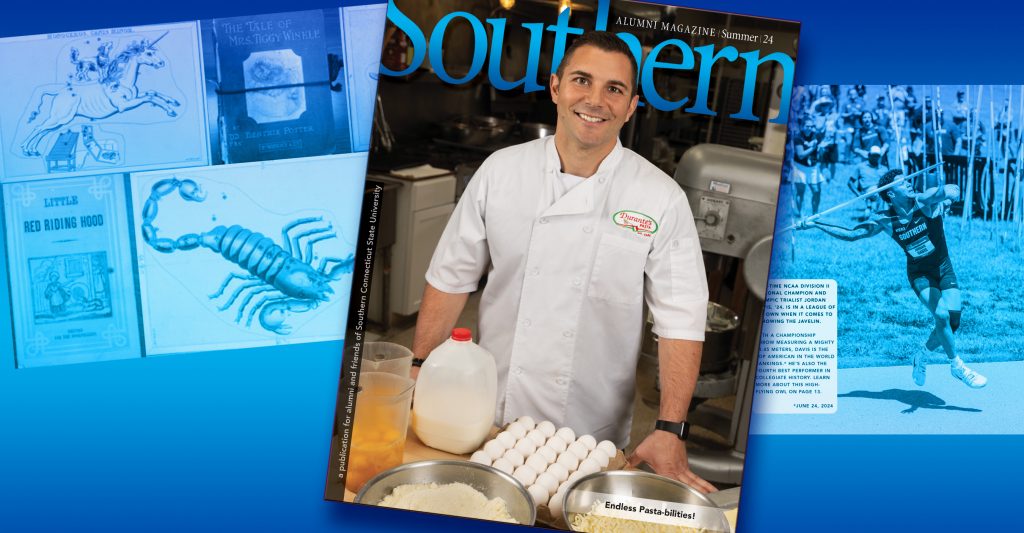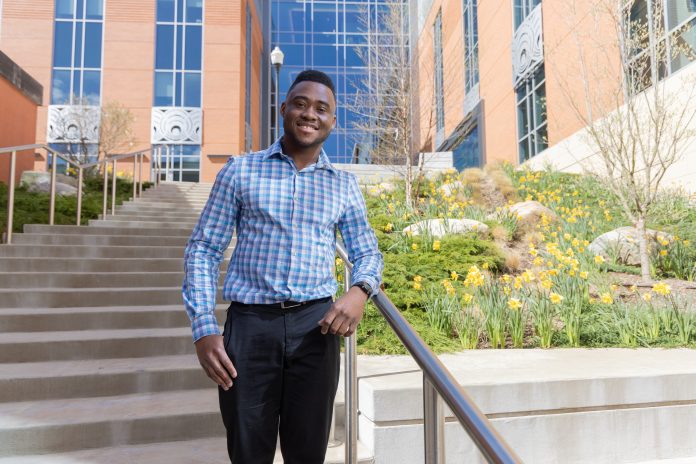SOMETIMES TIMING IS EVERYTHING. On March 11, 2020, the World Health Organization declared the COVID-19 outbreak a global pandemic, after more than 118,000 cases were reported in 114 countries. Three months later, Cephas Ayellakai, ’20, a recent graduate of Southern’s School of Nursing, was a newly hired critical care nurse at Yale New Haven Hospital’s Saint Raphael Campus — a frontline hero in the fight against COVID.
“I was a tech in the hospital at the start of the pandemic, so I had an idea what was coming. But none of us could have predicted the magnitude,” says Ayellakai, who graduated magna cum laud and received the Immaculata M. Alba Excellence in Nursing Practice Award, one of the School of Nursing’s top honors. Asked if he was nervous about launching his nursing career during the pandemic, he answers matter-of-factly. “This was what I signed up for,” he says. “I was going to do what I could to help.”
A commitment to caring continues to drive Ayellakai. In May 2023, he began the Doctor of Nurse Anesthesia Practice Program offered jointly by Yale New Haven Hospital School of Nurse Anesthesia and Central Connecticut State University. He is slated to graduate in May 2026.
Nurse anesthetists administer medications to keep patients asleep and pain free during surgery, while monitoring every biological function of the patient’s body. They’ve been caring for patients in the United State for more than 150 years. In fact, during World War I, nurse anesthetists were the main providers of anesthesia care to wounded soldiers on the front lines. Today, there are 46,540 nurse anesthetists practicing in the U.S. with an average annual salary of $205,770, according to the U.S. Bureau of Labor Statistics.
When he earns a doctorate and joins their ranks, Ayellakai, who is young (24), male, and Black, will be somewhat of an anomaly. The nurse anesthetist field, like the nursing profession overall, is marked by a lack of diversity. In 2021, about 85 percent of the nurse anesthetist workforce was white. In comparison, 6 percent were Asian, 4 percent were two or more races, 3 percent were Black, and 2 percent identified as other races. During the same period, 58 percent were women with an average age of 45.*
RAISED IN GHANA IN WEST AFRICA, Ayellakai dreamed of joining the medical profession since childhood. His father immigrated to the United States first; Ayellakai and two younger siblings temporarily stayed behind with their mother. “She fell ill for a while, and I was pretty much the one taking care of her,” says Ayellakai. ”Since then, I knew I would do something in medicine. I just wasn’t sure what that would look like.”
At age 16, Ayellakai immigrated to the U.S., along with the rest of his family. He’d spoken some English in Ghana. (It’s the national language, a relic of colonialism and a common bridge used along with about 80 other languages in the country.) Still, there were vast cultural differences between Ghana and the U.S. “Even accents are a barrier because they make it harder for people to understand each other,” he says, with a smile.
Still, Ayellakai excelled, attending Gateway Community College, then transferring to Southern. His adviser at Gateway recommended the program, and he had heard of the School of Nursing’s exceptional reputation. (Lauded by U.S. News & World Report, Southern is recognized as having the “Best RN Program in Connecticut” for 2024 by RegisteredNursing.org and Becker’s Hospital Review. Southern students had the highest average pass rate on the National Council Licensure Examination-RN, outperforming those from 20 RN programs evaluated in the state.)
Ayellakai recalls being extremely nervous at the start of his clinical experience. Kristen Borgognone, assistant professor of nursing, was the instructor. “I was very scared because I had never been to a hospital. But she was very patient and guided me through everything from talking to patients to thinking through clinical situations. I knew then I’d made the right decision to attend Southern,” he says.
Ayellakai’s future was further illuminated during a college internship at Yale’s Cardiothoracic Step-Down Unit. After transporting a patient to the Electrophysiology Lab, he talked briefly to a nurse anesthetist. The message he heard: “You could be me, one day.” As Ayellakai learned more about the career, it became increasingly appealing. “With a lot of advanced specialties, you tend to direct people instead of doing the work yourself. I love the hands-on involvement with anesthesia,” he says.
Looking forward, he hopes to inspire others to enter the field, including those from diverse backgrounds. It’s a goal echoed by the American Medical Association and the American Nurses Association. His advice to nursing students: start considering potential career paths as early as possible, ideally as an undergraduate.
“Working as a nurse, I would meet new grads on the med-surg floor. Most had never heard of a nurse anesthetist or thought about their long-term career goals. So, I’d talk to them about it. Let them know, ‘You can do this. Put in the time and the work.’ It’s all possible,” he says.
* Data USA, Deloitte
Read more from the summer 2024 issue of Southern Alumni Magazine



